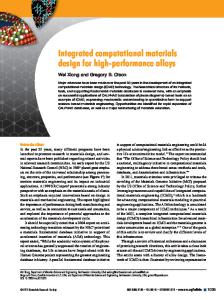Integrated CAD platform approach for Design for Additive Manufacturing of high performance automotive components
- PDF / 2,217,550 Bytes
- 11 Pages / 595.276 x 790.866 pts Page_size
- 90 Downloads / 373 Views
ORIGINAL PAPER
Integrated CAD platform approach for Design for Additive Manufacturing of high performance automotive components Enrico Dalpadulo1
· Fabio Pini1
· Francesco Leali1
Received: 13 April 2020 / Accepted: 25 July 2020 © Springer-Verlag France SAS, part of Springer Nature 2020
Abstract Use of Additive Manufacturing provides great potentials to settings focused on high performance products. It allows feasibility of sundry innovative features to completely rethink geometries and shapes and it leads to embrace new design approaches. The enhanced design freedom can be exploited to optimize products, using techniques such as topology optimization. The study of methods for development of optimized components to be produced by AM becomes therefore fundamental. A framework for the methodological approach to operations to be carried out from the concept model to the printed component has been analyzed and it is clear that issues and research efforts relapse both the global level of the workflow and the local level of singular tasks to be performed. Problems related to management of Design for Additive Manufacturing workflow can be solved with holistic approach, through the use of computer aided integrated tools. The aim of this work is to test the effectiveness at local level of such tools with respect to operations for both design and industrialization optimization, working on an automotive case study. In particular, specific tools for topology optimization, product simulation, printing preparation and process simulation are taken as reference and results obtained with an integrated CAD platform are discussed. Keywords Design for Additive Manufactruing · CAD based integrated platform · Powder Bed Fusion · High performance automotive components
1 Introduction Additive Manufacturing (AM), as opposed to subtractive manufacturing, is a technology to produce parts adding material layer upon layer. Its implementation offers great potentials for the design of high performance components. Implementation of AM technologies can provide many benefits, such as the possibility to produce components of every form and function, minimizing design methods issues, investment costs, development time, enabling re-thinking product development logics [1–3]. For example, small batches production, customizing costs reduction, complex and performance products become feasible removing manufacturing
B
Enrico Dalpadulo [email protected] Fabio Pini [email protected] Francesco Leali [email protected]
1
“Enzo Ferrari” Department of Engineering, University of Modena e Reggio Emilia, Modena, Italy
process constraints. Potentially, production can occur in less quantity, more late (Just-In-Time), with less waste materials, less energy, less goods transport and storage [4–6]. Advantages could interest also manufacturing management and control (assembly) and industrial logistics (part count) [7,8]. The idea of re-thinking product systems and sub-systems archetypes, with functional or multifunctional based design, re
Data Loading...











